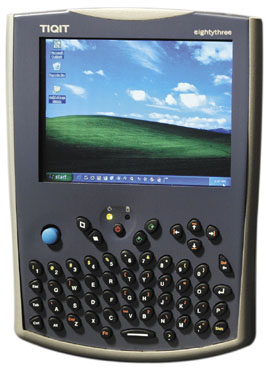|
|
Palm ColumnHigh time to kick in the hard drive by Shawn Barnett by Shawn BarnettOctober 2002, issue 46
Convergence is happening whether I like it or not. I'm still a greater fan of modularity, with an adaptable computer at the core to which you add the peripherals you need. It's worked for the PC industry. Admittedly, that's tougher to do with something as small as a PDA. They're generally stripped down to the bare essentials, and adding things like cables, wires, and snap-ons only make them cumbersome. Ultimately, if it's important enough, you blend it into the next version.
As a result, many convergence advocates seem to want the PDA to merge with a phone. It does give the PDA broader communication skills, and it also gives the phone the data it needs to dial a call. But I'm not sure that's for everyone, nor is it an ideal solution. Some of us like a simple phone that just places a call when we need to do some voice communication. I have a cell phone with buttons strategically placed to make sure I have quick access to the provider's Internet services, and I often get lost just trying to place a simple call. And I'm a gadget guy by trade.
Voice communication is an essential element of human interaction. Go ahead and integrate a PDA, but if any component of that PDA gets in the way of the core purpose for the phone, I can guarantee you the phone will not be a long-term success in the marketplace. And the market actually willing to spend extra on a phone with features most don't even know they need is small indeed.
Don't get me wrong. I think there are many of us who will buy and use these devices. There are bugs and problems to be worked out, but products like the Treo should do well enough. After all, there are many Palm OS fans out there who will want to give it a try. My point is that merging a cell phone and a PDA is not all there is to the future of mobile computing.
In fact, the Holy Grail of Wireless Data is actually a red herring. It's not as much about being able to pull data out of the air when you need it as it is about having the data with you when you need it. And not only the data, but the tools. I submit that when it's all over, people will only use these vaunted wireless tools some of the time. To check the news, the scores, maybe buy something. But we won't be accessing the data from our home computers wirelessly. Hackers and other scum-sucking fools will ensure that. And no, Larry, we won't be pulling down a silly word processor program wirelessly every time we need to write a letter to someone. The Network Computer not only never really lived, it will never go mobile. Tragically, wireless mobile devices as currently envisioned are similar to this ill-conceived network dependent model partially because of their insufficient internal storage. In the mobile world it's mainly done because it's necessary. At least it was.
The two products shown here are showing the way. The Apple iPod and the TIQIT eightythree come into a world of PDAs using volatile RAM and expensive memory cards to extend battery life and reduce size at the expense of capacity.
The iPod, a mobile music player that can hold thousands of MP3 songs on a single 5GB hard drive, took the market by storm with its capacity and innovative design. Others had already done the same, but not with such class, nor with this diminuitive size (achieved by using Toshiba's 1.8 inch hard drive). Applying the Palm's HotSync concept to music files, the little MP3 player both charges and syncs its songs at high speed via Firewire. It runs for 10 hours, yet is smaller than a Palm Pilot. And unlike a Palm, if the battery dies, all the data doesn't disappear; you don't need to reload lost songs and data from a svelte SD card, nor do you HotSync again. Just charge it back up and all the original data is there. Because like a PC, there's a hard drive in there.
When we compare the iPod to the current crop of MP3-playing PDAs, the PDAs are more than a step behind with their 128MB card capacities and slow upload speeds. Spending time selecting thirty songs to listen to ad nauseum until you bother to upload more later is like loading your CD holder with fifty CDs, only you get a lot fewer songs. The iPod eliminates this tedium, ensuring you have all the songs you love with you when you want to listen to or share them, without external cards, disks, or tapes. This can be done with all kinds of data, including contact information.
Next we have the TIQIT eightythree, a Pentium-class computer in a near-Palm-size case. I've only held one for a short time, but it's clear these guys saw the next wave coming and grabbed their surfboards for the ride. No, it's not a perfect concept. Part of the reason we need the Palm OS is that it is designed to interface with humans via a small screen. Windows XP was designed for humans using a desk, monitor, chair, keyboard, and mouse. The screen above is beautiful, but even with my excellent near vision, I would have eyestrain trying to read text this way. Notwithstanding, this is a promising product concept that could take the PDA world by surprise. I can already hear the pundits: "It's the Post PDA Era!"
They'd have a point. But they'd have missed the main point, dizzy from chasing their latest tale. In the broad sense, a Personal Computer is as much a Personal Digital Assistant as a Personal Digital Assistant is a Personal Computer. They both handle data in our digital world. And thanks to new technology, the day is gone where a Palm OS device can't have a hard drive. Miniturization has caught up and is enabling the components of the PC, formerly components of the mainframe, to reach down into the realm of the pocketable.
PDA makers of late have been focusing on giving us wireless access to public data via the Web. While I think that's important, I think they just might need to be reminded that the lion's share of PDA owners really want a PDA to carry their personal data (note the root word in PC and PDA). Phone numbers fit perfectly on any old Palm, but MP3, photos, videos, and even corporate documents continually require more storage.
It's hybrid PDA time. Such a device needs the Palm OS for the small screen, and an ATA interface for connecting via Firewire or USB 2.0. It eventually might evolve from a storage and transport device into a full PC, with a port for keyboard and monitor. It won't mark the end of an era, just another step in the continuing march to make personal computing more personal.
-Shawn Barnett, sab@pencomputing.com
|
|||
|
[Homepage] All contents ©1995-2000 Pen Computing Magazine, Inc. All rights reserved. |
||||




